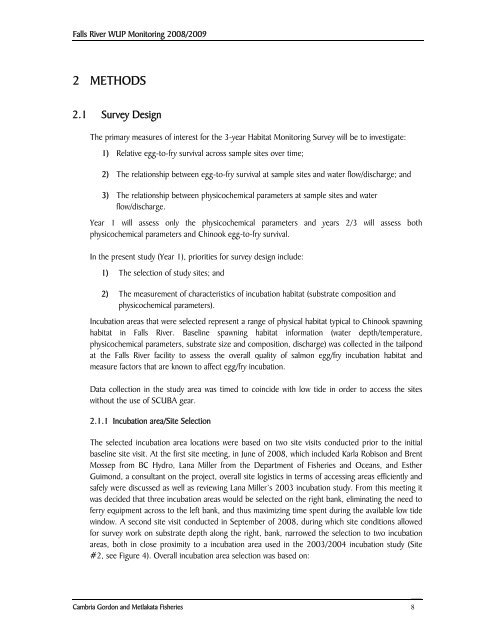Falls River Project Water Use Plan Falls River Fish ... - BC Hydro
Falls River Project Water Use Plan Falls River Fish ... - BC Hydro
Falls River Project Water Use Plan Falls River Fish ... - BC Hydro
Create successful ePaper yourself
Turn your PDF publications into a flip-book with our unique Google optimized e-Paper software.
<strong>Falls</strong> <strong>River</strong> WUP Monitoring 2008/2009<br />
2 METHODS<br />
2.1 Survey Design<br />
The primary measures of interest for the 3-year Habitat Monitoring Survey will be to investigate:<br />
1) Relative egg-to-fry survival across sample sites over time;<br />
2) The relationship between egg-to-fry survival at sample sites and water flow/discharge; and<br />
3) The relationship between physicochemical parameters at sample sites and water<br />
flow/discharge.<br />
Year 1 will assess only the physicochemical parameters and years 2/3 will assess both<br />
physicochemical parameters and Chinook egg-to-fry survival.<br />
In the present study (Year 1), priorities for survey design include:<br />
1) The selection of study sites; and<br />
2) The measurement of characteristics of incubation habitat (substrate composition and<br />
physicochemical parameters).<br />
Incubation areas that were selected represent a range of physical habitat typical to Chinook spawning<br />
habitat in <strong>Falls</strong> <strong>River</strong>. Baseline spawning habitat information (water depth/temperature,<br />
physicochemical parameters, substrate size and composition, discharge) was collected in the tailpond<br />
at the <strong>Falls</strong> <strong>River</strong> facility to assess the overall quality of salmon egg/fry incubation habitat and<br />
measure factors that are known to affect egg/fry incubation.<br />
Data collection in the study area was timed to coincide with low tide in order to access the sites<br />
without the use of SCUBA gear.<br />
2.1.1 Incubation area/Site Selection<br />
The selected incubation area locations were based on two site visits conducted prior to the initial<br />
baseline site visit. At the first site meeting, in June of 2008, which included Karla Robison and Brent<br />
Mossep from <strong>BC</strong> <strong>Hydro</strong>, Lana Miller from the Department of <strong>Fish</strong>eries and Oceans, and Esther<br />
Guimond, a consultant on the project, overall site logistics in terms of accessing areas efficiently and<br />
safely were discussed as well as reviewing Lana Miller’s 2003 incubation study. From this meeting it<br />
was decided that three incubation areas would be selected on the right bank, eliminating the need to<br />
ferry equipment across to the left bank, and thus maximizing time spent during the available low tide<br />
window. A second site visit conducted in September of 2008, during which site conditions allowed<br />
for survey work on substrate depth along the right, bank, narrowed the selection to two incubation<br />
areas, both in close proximity to a incubation area used in the 2003/2004 incubation study (Site<br />
#2, see Figure 4). Overall incubation area selection was based on:<br />
Cambria Gordon and Metlakata <strong>Fish</strong>eries 8
















